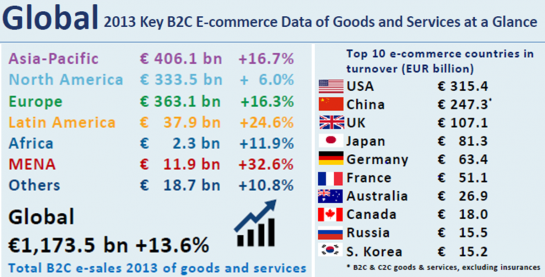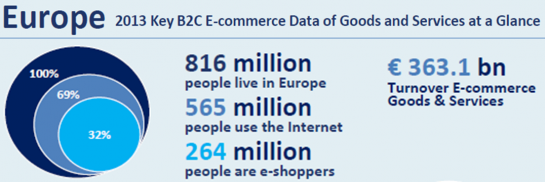In recent years e-commerce has reported staggering growth worldwide. In June 2014, Ecommerce Europe published its 2014 report on European e-commerce in the Business to Consumer (B2C) market for goods and services, offering an updated picture of the market size in Europe and the rest of the world.
According to the report, total turnover for e-commerce in the European market in 2013 was EUR 363 bn (+16% on 2012), a figure which is expected to grow to EUR 425 bn in 2014. The Asia-Pacific region is the global leader, with EUR 406 bn, while North America ranks third after Europe with EUR 334 bn.
Source: Ecommerce Europe Association
The biggest e-commerce markets in Europe are the UK, Germany and France. Together these three countries make up more than 60 percent of the entire European market. The fastest acceleration in recent years has been in Eastern Europe, with Russia rising by nearly 50 percent compared to last year. In 2013, Italy reported sales of EUR 11 bn (+20% on 2012).
Although, this figure is lower than in other European countries, the Italian market is regarded as one of the most promising, as demonstrated by the steep rise in the number of online buyers, which over the last three years has grown from 9 to 16 million.
Source: Ecommerce Europe Association
In such a dynamic global context, competition is based on the ability to offer a simple and consistent buying experience across all touch points. Accessibility and continuity are the keywords for the modern consumer: the web, product comparisons and careful consideration of reviews are the starting point for all purchases. Nonetheless, many ‘e-shoppers’ want the option of human contact and demand quality, competence and availability.
This is where Customer Service plays a key role. By providing quick and consistent answers (by phone, chat services, social media and email) to questions about products, payments, delivery times and return procedures, Customer Service is transformed from a cost center into a profit driver by exploiting the true value of e-commerce: establishing a relationship with the buyer. But the solidity of relationships is put to the test when problems arise (delays, undelivered products or other unexpected events).
And this is where Customer Service can show its mettle by restoring customers’ trust (and loyalty) through service that is consistently first class and integrated across multiple channels. Transcom has long experience of working with leading brands that offer various goods and services online. For example, clothing, fashion accessories, consumer electronics, travel, financial services and online payments. During the years, we have used our expertise to become a global outsourcer specialized in the ‘e-customer experience’:
- Innovation: We develop personalized customer care apps and automated self-care, automatic call-back solutions for our clients to improve the customer experience.
- Multilingualism: By offering services in many different languages, Transcom has helped many of our clients to expand into new markets.
- A multichannel approach and social customer care: We have agents who are specialized in the delicate process of managing online customer service conversations (Facebook, Twitter, chat etc).
- Flexibility: we can cater for seasonal peaks without compromising service quality, which is guaranteed by strict control procedures and ongoing training.
- Sales orientation: by using specialized teams and best practices tested worldwide, we know how to encourage retention and reacquisition, which translates into growth and value for the client.
- This value is also generated by cost reductions resulting from the mix of onshoring, nearshoring and offshoring services offered by Transcom.
Our clients confirm that they have achieved results which are both important and measurable. As the experts’ estimates demonstrate, e-commerce has huge potential. In this increasingly global, mobile and connected world, Transcom serves digital companies in all sectors with one goal in common: to become a market leader within their industry.